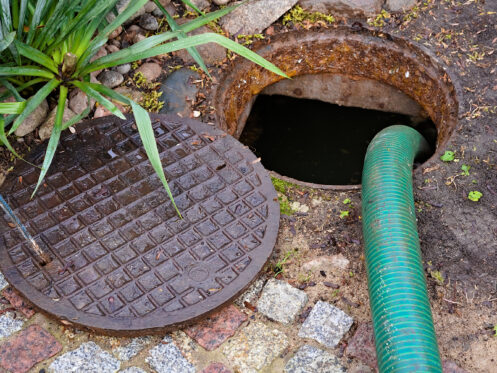Septic systems are designed to collect and treat all the wastewater produced by homes and businesses not connected to a municipal sewer system. Installing and repairing a septic system can be quite costly, so it is important to take steps to protect the lifespan of your system and maintain it in good condition. We’ll explain how long septic systems usually last, what factors can affect their lifespan and what steps are necessary to protect your system from failing prematurely.
Typical Lifespan for a Septic System
The lifespans of septic systems can vary quite a bit. Most septic tanks can last for 15 to 40 years, while a septic leach or drain field can often last for well over 50 years. To get the most out of your septic system, you need to make sure you keep it properly maintained. It’s also important that you get your septic tank pumped every few years.
The Importance of Septic Maintenance and Pumping
A properly maintained septic system that is pumped regularly will almost always last longer. Waiting too long to get your septic tank pumped is the worst thing you can do. When the layer of sludge and solid waste in a septic tank gets too high, it can lead to sewage backing up inside your home. An even bigger issue is that solid waste can start draining out into the leach field if your septic tank gets too full.
Most septic tanks have two compartments. When wastewater enters the first compartment, all the solids settle down near the bottom to rest on the sludge layer that is formed by bacteria breaking down the solid waste. There is a layer of water above the solids and a layer of scum, composed of things like fat, grease and oil, floating on top. Any time the plumbing system is used and waste enters the tank, it pushes some water through the outlet baffle. The baffle is located just below the normal water level to keep the scum in the first compartment rather than flowing out into the second compartment. As the water is forced through the baffle into the second compartment, it results in the same volume of water in this compartment flowing out into the leach field.
The leach field in a septic system works to dispose of all the wastewater. A leach field is composed of a series of perforated pipes buried underground. The wastewater slowly seeps out of the perforations into the soil, where bacteria then finish treating the water by feeding on any remaining waste. If a septic tank is too full, sometimes scum and solid waste can get pushed out through the baffles and end up in the leach field. When this happens, it usually ends up clogging the perforations so that no more water can drain out. This will eventually lead to waste backing up inside once the leach field pipes get full and the water has nowhere to go.
Unfortunately, this issue is usually fatal to a septic system, and the only way to fix it is by digging up the entire leach field and replacing it. This is precisely why regular septic pumping is so important. Most septic tanks need pumping every three to five years. However, this can depend in large part on the size of the tank and how much you use your septic system.
Other Factors That Can Affect How Long Your Septic System Lasts
Besides regular maintenance and pumping, there are a few other major factors that can impact a septic system’s lifespan. If you’re installing a new septic system or maintaining your existing system, these are some important considerations to keep in mind.
Type of Septic Tank
The material that a septic tank consists of is often one of the biggest factors in terms of how long it will last. The majority of septic tanks are made of concrete, which makes them extremely strong and durable. Concrete tanks will usually last for 40 years or more, but they can sometimes crack if they settle or get driven over.
Some septic systems, instead, have a high-density polyethylene (HDPE plastic) or fiberglass tank, and these will usually last 30 years or more when cared for properly. While HDPE and fiberglass aren’t necessarily bad options, they do have a few drawbacks. One is that both types are much lighter and more buoyant than concrete. They require additional work when installing to ensure they are fully anchored in the ground. If they’re not, there is a risk they could essentially float up to the surface over time. HDPE and fiberglass tanks also sometimes have steel baffles and other components that are prone to rusting out over time.
You may occasionally see older septic systems that have a solid steel tank. Steel septic tanks are seldom used nowadays since they experience lots of rust and corrosion over time and usually only last for 15 to 20 years.
Usage
Septic systems that get heavy usage on a regular basis generally won’t last as long as systems are only used for part of the year or only by a few people. Whether the system is used correctly is another major factor. Septic systems are only designed to dispose of toilet paper and human waste. If you wash lots of food scraps down the drain or flush other solids like paper towels, feminine hygiene products, condoms, wet wipes, etc., it will prevent your septic system from functioning properly and potentially shorten its lifespan.
The bacteria in the tank will easily break down toilet paper and human waste, but most other solids won’t get broken down nearly as easily. This causes the solid layer in the tank to build up much more quickly, which means the tank will need to be pumped more often, or issues will start to arise. Putting bleach and other chemicals into a septic system is another major issue since it will cause lots of the bacteria in the tank to die. When this happens, the waste won’t get broken down properly.
Soil Composition and Groundwater Conditions
The soil conditions around the septic system can also make a difference. For instance, soil that is more acidic will often start to break down a concrete tank over time. This is why a plastic or coated concrete tank is a better option for acidic soil.
Groundwater can also be a factor. Septic systems typically have more issues and don’t last as long in areas with a high water table. If the soil is often waterlogged, you’ll experience more issues with septic backups since all the water won’t be able to drain out if the soil is fully saturated. This issue is also why it’s important to install a septic system in an area with good drainage and without downspouts or other water sources that drain near the system.
If you need any plumbing, drain or sewer services in the Cheshire, CT area, F.F. Hitchcock Plumbing, Heating & Cooling is an HVAC and plumbing company you can count on. We’re a local, family-owned company with an A+ rating from the Better Business Bureau, and we also specialize in all heating and air conditioning services.
No matter what type of plumbing or HVAC service you need, contact us at F.F. Hitchcock Plumbing, Heating & Cooling today to ensure the job is done right!







